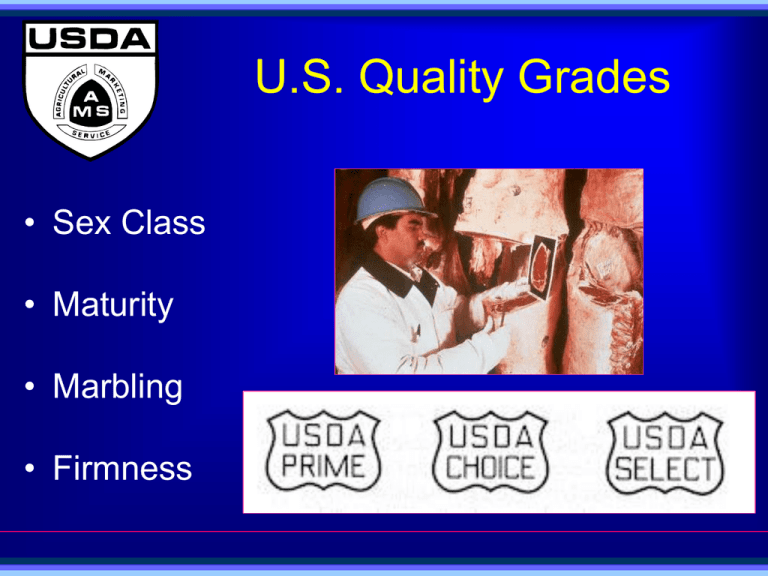
U.S. Quality Grades
• Sex Class
• Maturity
• Marbling
• Firmness
Purpose of Grading
• Facilitate the marketing of meat
• To sort carcasses from a
heterogeneous population into
homogeneous groups
Sex Class Determination
Steer vs Heifer
Trait
Steer
Heifer
Pizzle eye
Present
Absent
Semimembranosus
Square
shaped
Bean
shaped
Rough,
grape-like
Smooth in
appearance
Secondary sex fat
depot
USDA Beef Quality Grades
• Quality grades are an estimate of beef
palatability
Beef Palatability
• Tenderness
• Juiciness
• Flavor
USDA Quality Grades
• Grades of Youthful Carcasses (< 42 mos.)
Prime
Choice
Select
Standard
• Grades of Mature Carcasses (> 42 mos.)
Commercial
Utility
Cutter
Canner
USDA Quality Grades
Based on consideration of two general
factors:
1. Physiological Maturity
• Skeletal Maturity
• Lean Maturity
2. Marbling (Intramuscular Fat)
• Amount
• Distribution
USDA Beef Grades
USDA maturity and marbling scores
• Maturity Scores:
– A Youngest
–B
–C
–D
– E Oldest
Marbling scores: (Highest to
lowest)
-Abundant
-Moderately Abundant
-Slightly Abundant
-Moderate
-Modest
-Small
-Slight
-Practically Devoid
-Devoid
Shear Force Values
Relationship between tenderness
and USDA maturity scores
A
B
C
Maturity
D
E
Physiological Maturity vs Chronological Maturity
• The physiological maturity of the carcass is
an estimate of the actual chronological age of
the animal
USDA Maturity Score
A
B
C
D
E
Estimated chronological age
9 to 30 months
30 to 42 months
42 to 72 months
72 to 96 months
96 or more months
Physiological Maturity
• Skeletal Maturity is determined by
evaluating the condition of the cartilage
in the vertebral column, with heavy
emphasis placed on the cartilaginous
buttons at the end of the thoracic
vertebra
• Lean maturity is determined by the color
and firmness of the ribeye at the 12th
13th rib interface
Beef Skeletal Maturity
A00
% Thoracic
Ossification
0%
Approximate
Age (Months)
9 – 30
B00
10%
30 – 42
C00
35%
42 – 72
D00
70%
72 – 96
E00
90%
E100
100%
Maturity
Skeletal Maturity:
A00
B00
> 96
C00
D00
E00
Beef Skeletal Maturity
• Physiological Skeletal Ossification is only
marginally related to chronological age of the
live animal.
“A” and “B” Maturity Carcass Thoracic
Chine Buttons
“A” Maturity
“B” Maturity
A
SACRAL
DISTINCT
SEPARATION
LUMBAR
NO
OSSIFICATION
THORAIC
NO
OSSIFICATION
B
C
D
E
Physiological Maturity of Lumbar
Vertebrae of from carcasses with A40 and
A50 Overall Maturity Scores
A40
A50
A
B
C
SACRAL
DISTINCT
SEPARATION
FUSED
LUMBAR
NO
OSSIFICATION
NEARLY
COMPLETELY
OSSIFIED
COMPLETELY
OSSIFIED
THORAIC
NO
OSSIFICATION
SOME
OSSIFICATION
PARTIAL
OSSIFICATION
D
E
CONSID.
OSS.
OUTLINES
PLAINLY
VISIBLE
CONSID.
OSS.
OUTLINES
BARELY
VISIBLE
A
B
C
RIBS
SLIGHT
TENDENCY
TOWARDS
FLATNESS
SLIGHTLY
WIDE
AND
FLAT
TEXTURE
FINE
TENDS TO
BE FINE
SLIGHTLY
COARSE
COLOR
OF LEAN
MOD.
LIGHT
RED
SLIGHTLY
DARK
RED
MOD.
DARK
RED
D
MOD.
COARSE
E
COARSE
DARK
RED
Skeletal Maturity
A
B
C
D
E
Sacral
Distinct
separation
Some
separation
Fused
Fused
Fused
Lumbar
No
Partial
ossification ossification
Mostly
ossified
Ossified
Ossified
35-70%
70-90%
90% +
Thoracic*
0-10%
10-35%
*Average ossification of first three thoracic vertebra
Spinous
process of
the Thoracic
vertebra
“Buttons”
Thoracic
vertebra
Beef Quality Grades- Lean Maturity
Young
A00
Intermediate
B00
C00
Mature
D00
E00
Various Maturity of Beef Cattle
A-Maturity
C-Maturity
D-Maturity
Overall USDA Maturity
A-Maturity
Overall USDA Maturity
• Combine Skeletal & Lean
– Average
– If within 40 degrees- simple average
– > 40 degrees- average the degrees then
adjust 10 degrees toward bone
– If average of Skeletal & Lean crosses C/B
line, & skeletal is C- it stays with the
skeletal side
– Overall maturity cannot differ more than 1
full maturity from skeletal
USDA Quality-Marbling
• Marbling, or
intramuscular fat
flecks within the
exposed ribeye area
• Usually the major
factor determining
quality grade
Flecks of fat within the
encircled area
Marbling
Slight00
Small00
Modest00
Moderate00
Slightly Abundant00
Moderately Abundant00
USDA Quality Grades
Quality
Grade
Click
to add text
Marbling
Abundant
Mod. Abund.
Sl. Abund.
Moderate
Modest
Small
Slight
Traces
Pract. Dev.
A
B
Maturity
C
D
Prime
Commercial
Choice
Select
Standard
Utility
E
Overall USDA Maturity
• Determining Final Quality Grade
– A maturity overall- Marbling determines
Quality grade
– It takes a greater amount of marbling to
compensate for added maturity to receive
same Quality grade
– Overall maturity should be adjusted back to
respective Maturity 00 also creating an
adjusted marbling score
Overall USDA Maturity
• Determining Final Quality Grade
– Special rule- 1997- B maturity overall with
SM or SL marbling = High Std
– Everything else adjusted back to
respective Maturity 00
C
D
E
MD
SLAB
MAB
MT
MD
SLAB
SM
MT
MD
SL
SM
MT
TR
SL
SM
PD
TR
SL
USDA Yield Grades
Beef Yield Grades
• USDA Yield Grades predict the
percentage of carcass weight in
boneless, closely trimmed retail cuts
from the round, loin, rib and chuck
• Lean : Fat + Bone
USDA Yield Grades
Yield/Cutability estimates are
determined using four criteria
– Hot Carcass Weight, lbs
– Adjusted Fat Thickness, in.
– Ribeye Area, in2
– % KPH
History
• USDA developed the cutability equation
but it was not used because it was hard
to sort carcasses based on percentage
cutability.
• So, they developed the equation to
estimate yield grade and used those
grades (1,2,3,4,5) to sort carcasses
USDA Yield Grade
%BCTRC =
51.34 – 5.784(Adj.Fat) – 0.462(KPH) + 0.740(REA) – 0.0093(HCW)
USDA YG =
2.5 + 2.5(Adj.Fat) + 0.2(KPH) - 0.32(REA) + 0.0038(HCW)
USDA YG
%BCTRC
1
52.3 % or More
2
52.3 - 50.0%
3
50.0 - 47.7%
4
47.7 - 45.4%
5
45.4% or Less
USDA Yield Grade
•
•
FirstWe Will Use the 3-Step Short-Cut
Method to determine USDA Yield
Grade
4 parameters utilized in beef
yield grades
–
–
–
–
HCW
REA
Adj. Fat Thickness
% KPH
USDA Yield Grade
Step 1- Determine
Preliminary YG (PYG)
PYG= 2.0 + 0.25 YG for
every 0.1” of fat
NOTE: Report all PYG to
the nearest tenth of a
PYG- round up
Example- 0.3”= PYG- 2.75
2.75= 2.8
Fat Thickness
PYG
0.0
2.0
0.1
2.25
0.2
2.5
0.3
2.75
0.4
3.0
0.5
3.25
0.6
3.5
0.7
3.75
0.8
4.0
0.9
4.25
1.0
4.5
1.1
4.75
1.2
5.0
USDA Yield Grade
Step 2- Determine Ribeye
(REA) adjustment/ Hot
Carcass Wt (HCW)
IF INBETWEEN WTS- USE
9-8-8 Rule
EXAMPLE- 608 lbs needs
11.0; 609 lbs needs
11.1
616 lbs needs 11.1; 617 lbs
needs 11.2
Carcass Wt
Req. REA
550
10.4
575
10.7
600
11.0
625
11.3
650
11.6
675
11.9
700
12.3
725
12.5
750
12.8
775
13.1
800
13.4
825
13.7
850
14.0
875
14.3
900
14.6
925
14.9
950
15.2
Carcass Wt
Req. REA
550
10.4
575
10.7
600
Step 2- Continued- Determine
Ribeye (REA) adjustment/ Hot 625
650
Carcass Wt (HCW)
675
Req. REA- Actual REA =Adj. Factor 700
725
3
750
ONLY Tenths of a YG Adjustment 775
Actual > Req. = Subtract Adj Factor 800
825
Req. > Actual= Add Adj Factor
11.0
850
14.0
875
14.3
900
14.6
925
14.9
950
15.2
USDA Yield Grade
11.3
11.6
11.9
12.3
12.5
12.8
13.1
13.4
13.7
Carcass Wt
Req. REA
USDA Yield Grade
550
10.4
575
10.7
Step 2- Example
717 lb carcass needs 12.4 in REA
Actual REA- 15.3
12.4 – 15.3 = .966
3
Adj Factor= -1.0
600
11.0
625
11.3
650
11.6
675
11.9
700
12.3
725
12.5
750
12.8
775
13.1
800
13.4
825
13.7
850
14.0
875
14.3
900
14.6
925
14.9
950
15.2
USDA Yield Grade
Step 3- % Kidney, Pelvic and Heart
Fat
Base = 3.5% +/- .5%= +/- 0.1 YG
% KPH
YG ADJ
5.0
+.3
4.5
+.2
4.0
+.1
3.5
0.0
3.0
-.1
2.5
-.2
2.0
-.3
1.5
-.4
1.0
-.5
0.5
-.6
USDA Yield Grade Calculation
•
•
•
•
Fat thickness = 0.5 in PYG=3.25 ≈ 3.3
HCW = 750 lbReq. REA- 12.8
Actual REA- 14.1
12.8 – 14.1 = -.433 = Adj Factor= -.4
3
• 2.5% KPH= -.2
• Final YG= 2.7
– For this class, all yield grades are calculated
to the nearest 0.1 yield grade (range: 1.0-5.9)
with no rounding
USDA Yield Grade
•
•
NextWe Will Use the 4-Step Method
to determine USDA Yield Grade
Again, 4 parameters utilized in
beef yield grades
– HCW
– REA
– Adj. Fat Thickness
– % KPH
-Main difference between 3 and 4-step
method is in the 4-step method
HCW and REA are not combined,
accounting for the extra step.
USDA Yield Grade
Step 1- Determine
Preliminary YG (PYG)
PYG= 2.0 + 0.25 YG for
every 0.1” of fat
NOTE: Report all PYG to
the nearest tenth of a
PYG- round up
Example- 0.3”= PYG- 2.75
2.75= 2.8
Fat Thickness
PYG
0.0
2.0
0.1
2.25
0.2
2.5
0.3
2.75
0.4
3.0
0.5
3.25
0.6
3.5
0.7
3.75
0.8
4.0
0.9
4.25
1.0
4.5
1.1
4.75
1.2
5.0
USDA Yield Grade
Step 2- Determine weight
adjustment adjustment
-Starts with a base of
600lbs and every
increase in 25lbs is an
increase in adjustment
of 0.1
-Round on the 13
-Ex- a carcass that weighs
762lbs needs to be
adjusted +0.6, but a
carcass that weighs
763lbs needs to be
adjusted +0.7
Carcass Wt
adjustment
550
-0.2
575
-0.1
600
0
625
+0.1
650
+0.2
675
+0.3
700
+0.4
725
+0.5
750
+0.6
775
+0.7
800
+0.8
825
+0.9
850
+1.0
875
+1.1
900
+1.2
925
+1.3
950
+1.4
USDA Yield Grade
Step 3- Determine ribeye
(REA) adjustment
adjustment
-Starts with a base of 11
square inches, and
every increase in 1inch
is an increase in
adjustment of 0.3
-Easiest to call ribeyes on a
“3-7-0” system. (all
ribeyes end in .3, .7 or
.0 as seen in the chart
---------------------------_
Ribeye area
adjustment
10.7
+0.1
11.0
0
11.3
-.01
11.7
-0.2
12.0
-0.3
12.3
-0.4
12.7
-0.5
13.0
-0.6
13.3
-0.7
13.7
-0.8
14.0
-0.9
14.3
-1.0
14.7
-1.1
15.0
-1.2
15.3
-1.3
15.7
-1.4
16.0
-1.5
USDA Yield Grade
Step 4- % Kidney, Pelvic and Heart
Fat
Base = 3.5% +/- .5%= +/- 0.1 YG
% KPH
YG ADJ
5.0
+.3
4.5
+.2
4.0
+.1
3.5
0.0
3.0
-.1
2.5
-.2
2.0
-.3
1.5
-.4
1.0
-.5
0.5
-.6
USDA Yield Grade Calculation
•
•
•
•
•
•
Fat thickness = 0.5 in PYG=3.25 ≈ 3.3
HCW = 750 lb- +0.6
REA- 14.1
14.1-11.0=3.1X0.3=-0.9
2.5% KPH= -.2
Final YG= 2.8
– For this class, all yield grades are calculated
to the nearest 0.1 yield grade (range: 1.0-5.9)
with no rounding








